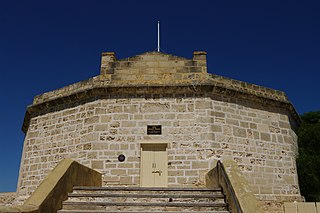
Fremantle is a port city in Western Australia, located at the mouth of the Swan River in the metropolitan area of Perth, the state capital. Fremantle Harbour serves as the port of Perth. The Western Australian vernacular diminutive for Fremantle is Freo.

Albany is a port city in the Great Southern region in the Australian state of Western Australia, 418 kilometres (260 mi) southeast of Perth, the state capital. The city centre is at the northern edge of Princess Royal Harbour, which is a part of King George Sound. The central business district is bounded by Mount Clarence to the east and Mount Melville to the west. The city is in the local government area of the City of Albany. While it is the oldest colonial, although not European, settlement in Western Australia - predating Perth and Fremantle by over two years - it was a semi-exclave of New South Wales for over four years until it was made part of the Swan River Colony.

Curtin University, formerly known as Curtin University of Technology and Western Australian Institute of Technology (WAIT), is an Australian public research university based in Bentley, Perth, Western Australia. It is named after John Curtin, Prime Minister of Australia from 1941 to 1945, and is the largest university in Western Australia, with 58,607 students in 2022.

Cottesloe is a western suburb of Perth, Western Australia, within the Town of Cottesloe. Cottesloe was named for Thomas Fremantle, 1st Baron Cottesloe, a prominent Tory politician and the brother of Admiral Sir Charles Fremantle for whom the city of Fremantle was named. The nearby suburb of Swanbourne was named for the Fremantle family seat, Swanbourne House, in Swanbourne, Buckinghamshire.

The Round House was the first permanent building built in the Swan River Colony. Built in late 1830 and opened in 1831, it is the oldest building still standing in Western Australia.

Perth Modern School is a public co-educational academically selective high school, located in Subiaco, an inner city suburb of Perth, Western Australia. Perth Modern is Western Australia's only fully academically selective public school. Established in 1911, the school is both the oldest public high school and the oldest co-educational high school in Western Australia (WA).

Council House is a 13-storey office building on St Georges Terrace in Perth, Western Australia. Located beside Stirling Gardens and Government House in the city's central business district, the 49.8-metre (163 ft) building was designed by Howlett and Bailey Architects and opened by Queen Elizabeth II in 1963, after Perth hosted the 1962 British Empire and Commonwealth Games. For most of its history, it has served as the headquarters for the City of Perth.
The Public Works Department (PWD) was the State Government Agency of Western Australia, which was charged with providing and maintaining public infrastructure such as dams, water supplies, schools, hospitals, harbours and other public buildings. The department is no longer operational, having its responsibilities reassigned to other State Government Departments and corporate entities since 1985.

Perth Institute of Contemporary Arts (PICA) is a contemporary visual and performance arts venue located in a heritage-listed building in Perth, Western Australia.

London Court is a three and four-level open-roofed shopping arcade located in the central business district in Perth, Western Australia. It was built in 1937 by wealthy gold financier and businessman Claude de Bernales for residential and commercial purposes. The arcade runs between the Hay Street Mall and St Georges Terrace and is considered an important tourist attraction in the City of Perth. It received a National Trust of Australia classification in 1978 and was recorded in the Register of the National Estate in 1982. The Heritage Council of Western Australia included it in the State Heritage Register in 1996.

The Old Court House is the first court building constructed in Perth, Western Australia. It is located between Stirling Gardens and Supreme Court Gardens, off Barrack Street, adjacent to the Supreme Court building. It is a single-storey cream rendered building, with a wooden shingle roof.

The 1910 Perth Technical School building is located at 137 St Georges Terrace, Perth, Western Australia, adjacent to the Old Perth Boys School building, which had served as part of the school's former temporary premises since opening of classes there on 16 May 1900.

Clackline is a locality in the Wheatbelt region of Western Australia, about 80 kilometres (50 mi) east-north-east of Perth.

Henry Trigg (1791–1882) was the Superintendent of Public Works in Western Australia from 1839 to 1851 and founder of the Congregational Church in Perth.
Central Institute of Technology was a Technical and Further Education (TAFE) institution based in Perth, Western Australia until 2016 when it became a part of North Metropolitan TAFE. It was the equal oldest post-secondary educational institution in Western Australia and the largest TAFE institution in Perth. Historically it was also known by the names of Perth Technical College, Central Metropolitan College of TAFE (CMC) and Central TAFE. On April 11, 2016 following a reform of all TAFEWA colleges, Central Institute of Technology amalgamated with West Coast Institute of Training and became known as North Metropolitan TAFE.
Henry Willey Reveley (1788–1875) was a civil engineer responsible for the earliest public works at the Swan River Colony, the foundation of the state of Western Australia.
Between 1891 and 1985 the Principal Architect of the Public Works Department was responsible for the delivery of the state government’s public buildings capital works program throughout Western Australia.

Northbridge is an inner city suburb of Perth, Western Australia, historically separated from Perth's central business district by the Fremantle and Joondalup railway lines. It is part of the City of Perth local government area.

The Fremantle School building is a heritage-listed building located at 92 Adelaide Street, Fremantle. It was known for a long time by the name of its later occupants, the Film and Television Institute.


















